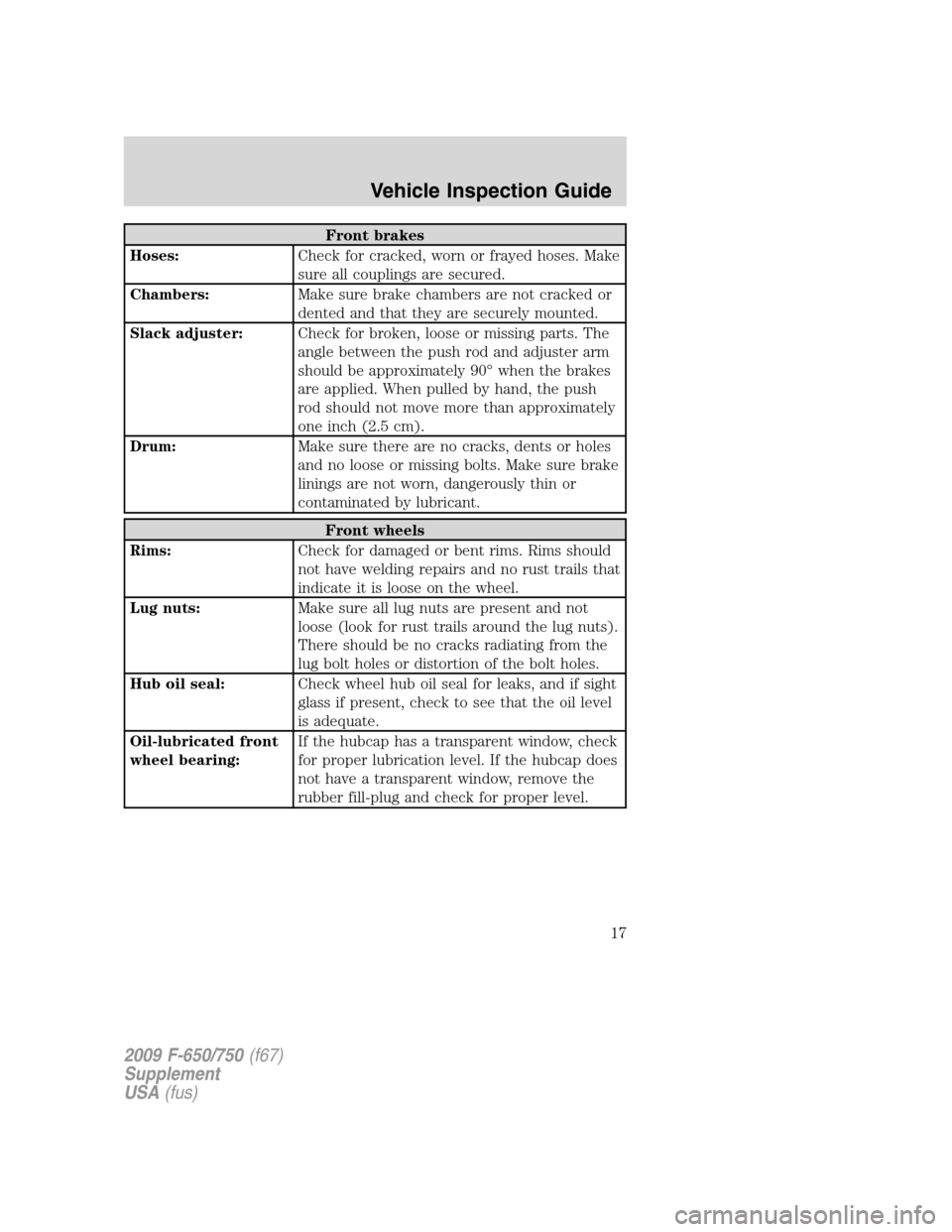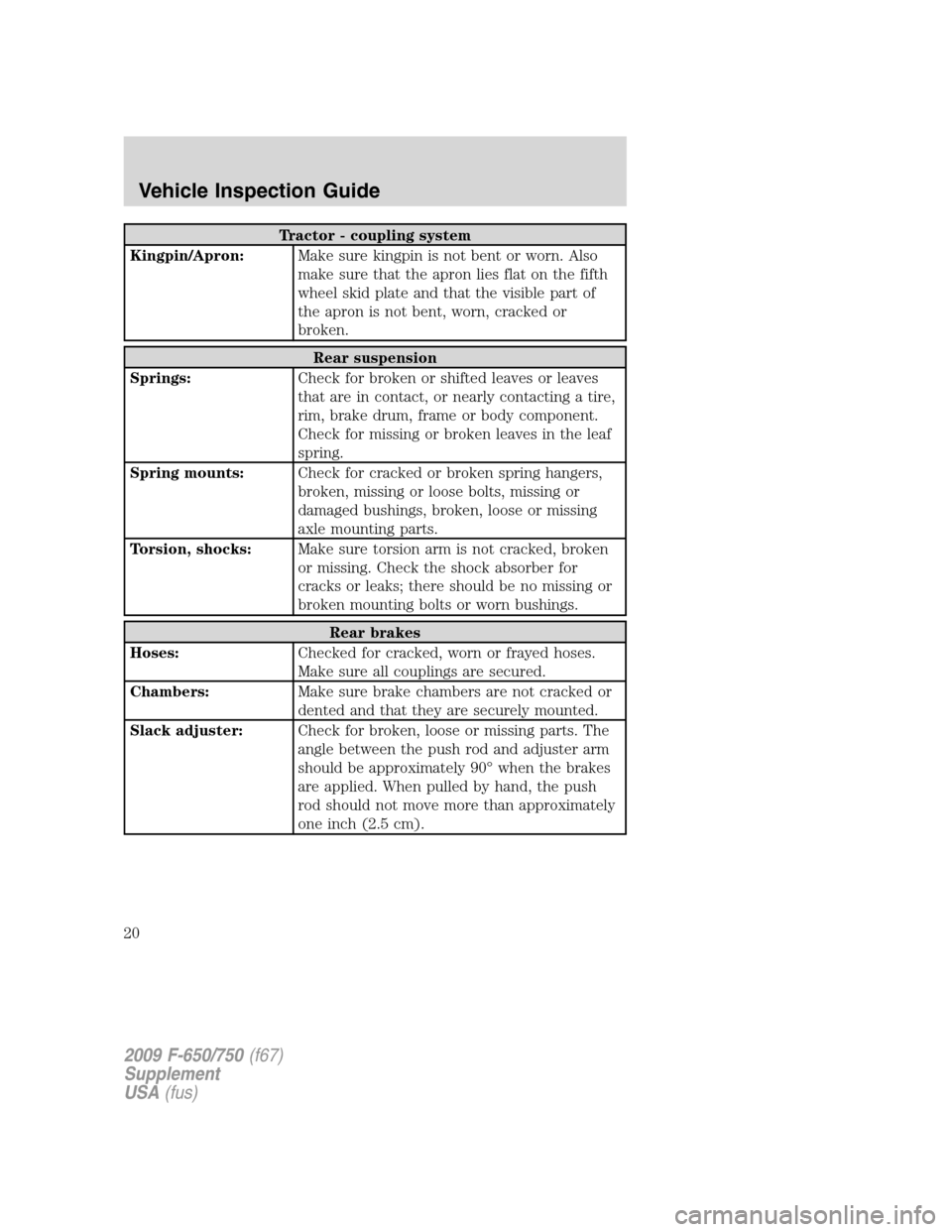Page 1 of 276
Introduction 4
Safety and environment protection 4
Vehicle Inspection Guide 11
Instrument Cluster 22
Warning lights and chimes 22
Gauges 28
Entertainment Systems 33
AM/FM stereo 33
AM/FM stereo with in-dash six CD 40
Climate Controls 46
Heater only 46
Manual heating and air conditioning 47
Lights 49
Headlamps 49
Turn signal control 50
Interior lamps 51
Bulb replacement 51
Driver Controls 54
Windshield wiper/washer control 54
Steering wheel adjustment 54
Power windows 56
Mirrors 57
Speed control 59
Locks and Security 64
Keys 64
Locks 64
Seating and Safety Restraints 65
Seating 65
Safety restraints 69
Child restraints 79
Table of Contents
1
2009 F-650/750(f67)
Supplement
USA(fus)
Page 7 of 276

Cell phone use
The use of Mobile Communications Equipment has become increasingly
important in the conduct of business and personal affairs. However,
drivers must not compromise their own or others’ safety when using
such equipment. Mobile Communications can enhance personal safety
and security when appropriately used, particularly in emergency
situations. Safety must be paramount when using mobile communications
equipment to avoid negating these benefits.
Mobile Communication Equipment includes, but is not limited to cellular
phones, pagers, portable email devices, in-vehicle communications
systems, telematics devices and portable two-way radios.
WARNING:Driving while distracted can result in loss of vehicle
control, accident and injury. Ford strongly recommends that
drivers use extreme caution when using any device that may take their
focus off the road. The drivers primary responsibility is the safe
operation of their vehicle. Only use cell phones and other devices not
essential to the driving task when it is safe to do so.
2009 F-650/750(f67)
Supplement
USA(fus)
Introduction
7
Page 17 of 276

Front brakes
Hoses:Check for cracked, worn or frayed hoses. Make
sure all couplings are secured.
Chambers:Make sure brake chambers are not cracked or
dented and that they are securely mounted.
Slack adjuster:Check for broken, loose or missing parts. The
angle between the push rod and adjuster arm
should be approximately 90° when the brakes
are applied. When pulled by hand, the push
rod should not move more than approximately
one inch (2.5 cm).
Drum:Make sure there are no cracks, dents or holes
and no loose or missing bolts. Make sure brake
linings are not worn, dangerously thin or
contaminated by lubricant.
Front wheels
Rims:Check for damaged or bent rims. Rims should
not have welding repairs and no rust trails that
indicate it is loose on the wheel.
Lug nuts:Make sure all lug nuts are present and not
loose (look for rust trails around the lug nuts).
There should be no cracks radiating from the
lug bolt holes or distortion of the bolt holes.
Hub oil seal:Check wheel hub oil seal for leaks, and if sight
glass if present, check to see that the oil level
is adequate.
Oil-lubricated front
wheel bearing:If the hubcap has a transparent window, check
for proper lubrication level. If the hubcap does
not have a transparent window, remove the
rubber fill-plug and check for proper level.
2009 F-650/750(f67)
Supplement
USA(fus)
Vehicle Inspection Guide
17
Page 18 of 276

WARNING:If a wheel must be changed, obtain expert tire
service help. Mounting and un-mounting of tires should only be
performed by a qualified technician using necessary safety procedures
and equipment, otherwise the result could be property damage,
personal injury or death.
Driver/Fuel area
Fuel tank(s):Make sure the fuel tank(s) and cap(s) are
secure. Make sure there is no damage to the
tank(s).
Leaks:Check for any leaks from the fuel tank(s).
Underbody of vehicle
Driveshaft:Make sure that the driveshaft is not bent or
cracked. Ensure all driveshaft couplings are
secure.
Exhaust system:Make sure the outside visible parts are
securely mounted. Make sure there are no
cracks, holes or severe dents.
Frame:Check for cracks or bends in longitudinal
frame members. Make sure there are no loose,
cracked, bent, broken or missing
crossmembers or crossmember fasteners.
WARNING:Maintain adequate clearance between all parts of
the exhaust system and all hoses, wires and lines for engine
cooling, brake system, fuel system, power steering system and
electrical system, Heat damage to hoses, wires or lines may cause
vehicle malfunction that could result in property damage, personal
injury or death.
2009 F-650/750(f67)
Supplement
USA(fus)
Vehicle Inspection Guide
18
Page 19 of 276

Rear of vehicle
Air/Electric lines:Make sure that air hoses are not cut, cracked,
chafed or worn. Listen for audible air leaks,
Make sure air and electrical lines are not
tangled, crimped or pinched or being dragged
against any truck parts. Electrical line
insulation should not be cut, cracked, chafed
or worn. None of the air or electrical line
should be spliced or taped. Check for
corrosion on pins and in electrical sockets to
ensure continuity and reduced heat build-up
potential.
Deck plate:Make sure deck plate is clean, securely bolted
to the frame and clear of loose objects.
Signal/Brake lights:Make sure both brake lights illuminate when
the brake pedal is applied. Also, make sure
each signal flashes. Make sure that four-way
flashers work properly.
Lights, reflectors:Make sure all lights illuminate and are clean.
Make sure headlights function on both high
and low beams. Make sure reflectors are clean
and unbroken and of proper color (red on
rear, amber elsewhere). Make sure the running
lights are also clean and unbroken. Rear
running lights must be checked separately
from signal, flasher and brake lights.
Tractor - coupling system
Mounting bolts:Check for loose or missing mounting brackets,
clamps, bolts or nuts. Both fifth wheel and
slide mounting must be solidly attached.
Platform:Check for cracks or breaks in the platform
structure.
Safety latch:Make sure safety latch is engaged.
Release arm:Make sure safety latch is in the engaged
position and that any safety latch is in place.
2009 F-650/750(f67)
Supplement
USA(fus)
Vehicle Inspection Guide
19
Page 20 of 276

Tractor - coupling system
Kingpin/Apron:Make sure kingpin is not bent or worn. Also
make sure that the apron lies flat on the fifth
wheel skid plate and that the visible part of
the apron is not bent, worn, cracked or
broken.
Rear suspension
Springs:Check for broken or shifted leaves or leaves
that are in contact, or nearly contacting a tire,
rim, brake drum, frame or body component.
Check for missing or broken leaves in the leaf
spring.
Spring mounts:Check for cracked or broken spring hangers,
broken, missing or loose bolts, missing or
damaged bushings, broken, loose or missing
axle mounting parts.
Torsion, shocks:Make sure torsion arm is not cracked, broken
or missing. Check the shock absorber for
cracks or leaks; there should be no missing or
broken mounting bolts or worn bushings.
Rear brakes
Hoses:Checked for cracked, worn or frayed hoses.
Make sure all couplings are secured.
Chambers:Make sure brake chambers are not cracked or
dented and that they are securely mounted.
Slack adjuster:Check for broken, loose or missing parts. The
angle between the push rod and adjuster arm
should be approximately 90° when the brakes
are applied. When pulled by hand, the push
rod should not move more than approximately
one inch (2.5 cm).
2009 F-650/750(f67)
Supplement
USA(fus)
Vehicle Inspection Guide
20
Page 26 of 276

Trailer Anti-lock Brake System
(ABS):Illuminates briefly when the
engine is powered-up and only when
a PLC trailer or a PLC diagnostic
tool is connected. If the light
remains on after the vehicle is started, continues to flash or fails to
illuminate, have the system serviced immediately.
Anti-lock Brake System (ABS):If
the ABS light stays illuminated or
continues to flash, a malfunction has
been detected, have the system
serviced immediately. Normal
braking is still functional unless the brake warning light also is
illuminated.
Check trans (Allison automatic
transmission only):The lamp will
illuminate for several seconds after
the ignition is turned to the ON
position. Illumination of this light while driving indicates that a problem
has been detected and shifting may be restricted. Depending upon the
severity of the problem, the read-out digit on the shifter display may be
blank. Operation may continue in order to reach service assistance. The
ECU may not respond to shift selector requests, since operating
limitations are being placed on the transmission, i.e. upshifts and
downshifts may be restricted. Direction changes will not occur.
Refer to your transmission operator’s manual for more information.
Safety belt:Reminds you to fasten
your safety belt.
Range inhibit:Illuminates when
the transmission is not engaged in
the selected gear. The warning light
will go off when the gearshift lever
is adjusted in to the appropriate gear.
Refer to your transmission operator’s manual for more information.
ABS
CHECK
TRANS
RANGE
INHIBIT
2009 F-650/750(f67)
Supplement
USA(fus)
Instrument Cluster
26
Page 64 of 276
KEYS
The key operates all locks on your vehicle. In case of loss, replacement
keys are available from your dealer.
You should always carry a second key with you in a safe place in case
you require it in an emergency.
POWER DOOR LOCKS (IF EQUIPPED)
Press U to unlock all doors and L to
lock all doors.
U L
2009 F-650/750(f67)
Supplement
USA(fus)
Locks and Security
64